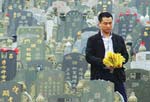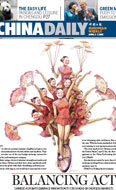Asia
UN: High radiation outside Japan's exclusion zone
Updated: 2011-03-31 10:47
(Agencies)
VIENNA - Recent radiation readings outside the exclusion zone around Japan's nuclear disaster show radiation substantially higher than levels at which the UN nuclear agency would recommend evacuations, agency officials said Wednesday.
The comments could add to the debate over how far people need to stay away from Japan's Fukushima Dai-ichi nuclear complex, which was crippled in the country's March 11 earthquake and tsunami.
Elena Buglova, an official from the International Atomic Energy Agency, said the reading was 2 megabecquerels per square meter at the village of Iitate, adding that "as a ratio it was about two times higher" than levels at which the agency recommends evacuations.
Iitate is about 25 miles (40 kilometers) from the Fukushima complex where emergency crews are battling to keep radioactivity from spreading.
Japanese officials have told residents to evacuate within a 12-mile (20-kilometer) zone and to stay indoors within 18 miles (30 kilometers) of the damaged complex, but US officials have recommended citizens stay at least 50 miles (80 kilometers) away.
The officials emphasized that the readings at the village of Iitate were sporadic and only at one measuring point. They did not say exactly when the readings were taken but mentioned them along with radiation measurements of iodine 131 and cesium 137 in soil samples between March 18 and March 26.
Denis Flory, a senior IAEA official, demurred when asked whether the agency was recommending that the village be cleared of residents but said it had advised Japanese authorities to "carefully assess the situation."
"The highest values were found in a relatively small area in the northwest from the Fukushima power plant and the first assessment indicates that one of the IAEA operational criteria for evacuation is exceeded in Iitate village," he told reporters.
Buglova also indicated the readings were preliminary saying "there is a range of uncertainty involved."
Exceeding the evacuation limit does not necessarily mean the levels pose a serious health risk, as they are often extremely conservative and set well below where health damage can be expected.
Japan's health ministry has previously advised Iitate villagers not to drink tap water due to elevated levels of iodine.
Separately, agency officials said Singapore authorities had measured radiation readings from cabbage imported from Japan that were up to nine times above international recommended safety levels _ iodine 131 readings of up to 936 becquerels per kilogram.
Earlier, IAEA head Yakima Amano told reporters that he had issued invitations to government ministers from the agency's 151 member nations to attend a June conference on safety procedures at nuclear plants worldwide in the wake of the Japan disaster.
Amano said the conference will focus on assessments of the Fukushima Dai-ichi disaster and lessons that need to be learned from it.
E-paper

Green mission
Tony blair believes China will take a leading role to fight climate change and cut emissions.
Stepping on to success
French connection
Generation gaps
Specials

Have you any wool?
The new stars of Chinese animation are edging out old childhood icons like Mickey Mouse and Hello Kitty.

Fill dad's shoes
Daughter and son are beginning to take over the family business of making shoes.

Virtual memorial
High-Tech touches to traditional tombsweeping festival help environment.
